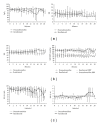Dexmedetomidine versus Remifentanil for Sedation during Awake Fiberoptic Intubation
- PMID: 22844277
- PMCID: PMC3403510
- DOI: 10.1155/2012/753107
Dexmedetomidine versus Remifentanil for Sedation during Awake Fiberoptic Intubation
Abstract
This study compared remifentanil and dexmedetomidine as awake fiberoptic intubation (AFOI) anesthetics. Thirty-four adult ASA I-III patients were enrolled in a double-blinded randomized pilot study to receive remifentanil (REM) or dexmedetomidine (DEX) for sedation during AFOI (nasal and oral). Thirty patients completed the study and received 2 mg midazolam IV and topical anesthesia. The REM group received a loading dose of 0.75 mcg/kg followed by an infusion of 0.075 mcg/kg/min. The DEX group received a loading dose of 0.4 mcg/kg followed by an infusion of 0.7 mcg/kg/hr. Time to sedation, number of intubation attempts, Ramsay sedation scale (RSS) score, bispectral index (BIS), and memory recall were recorded. All thirty patients were successfully intubated by AFOI (22 oral intubations/8 nasal). First attempt success rate with AFOI was higher in the REM group than the DEX group, 72% and 38% (P = 0.02), respectively. The DEX group took longer to attain RSS of ≥3 and to achieve BIS <80, as compared to the REM group. Postloading dose verbal recall was poorer in the DEX group. Dexmedetomidine seems a useful adjunct for patients undergoing AFOI but is dependent on dosage and time. Further studies in the use of dexmedetomidine for AFOI are warranted.
Figures

References
-
- Guglielmi M, Urbaz L, Tedesco C, Pusceddu A, Sogni A, Ronzoni G. A structured training program for awake fiber optic intubation: teaching the complete package. Minerva Anestesiologica. 2010;76(9):699–706. - PubMed
-
- Péan D, Floch H, Beliard C, et al. Propofol versus sevoflurane for fiberoptic intubation under spontaneous breathing anesthesia in patients difficult to intubate. Minerva Anestesiologica. 2010;76(10):780–786. - PubMed
-
- Donaldson ABP, Meyer-Witting M, Roux A. Awake fibreoptic intubation under remifentanil and propofol target-controlled infusion. Anaesthesia and Intensive Care. 2002;30(1):93–95. - PubMed
-
- Neidhart G, Kovács AF, Bremerich DH, Kessler P. Remifentanil/propofol for fiberoptic intubation. A case report. Anaesthesist. 2000;49(6):523–526. - PubMed
-
- Machata AM, Gonano C, Holzer A, et al. Awake nasotracheal fiberoptic intubation: patient comfort, intubating conditions, and hemodynamic stability during conscious sedation with remifentanil. Anesthesia and Analgesia. 2003;97(3):904–908. - PubMed
LinkOut - more resources
Full Text Sources
Medical
Miscellaneous

